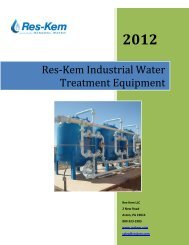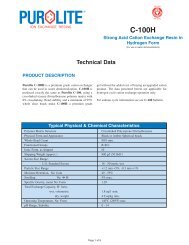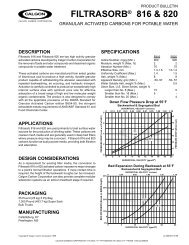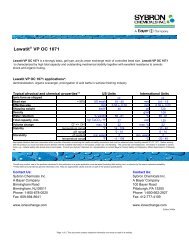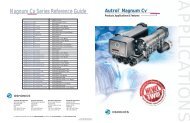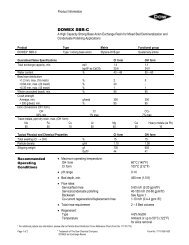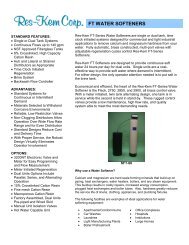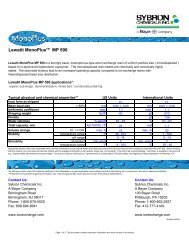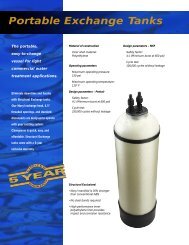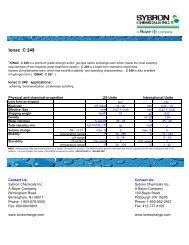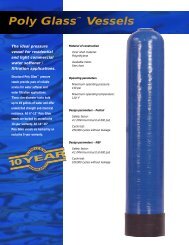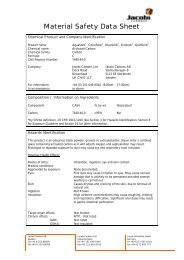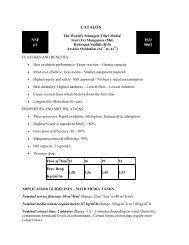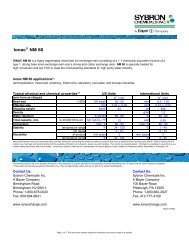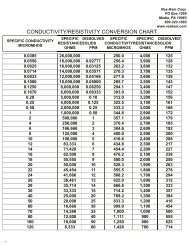DOWEX Ion Exchange Resins WATER CONDITIONING MANUAL
DOWEX Ion Exchange Resins WATER CONDITIONING MANUAL
DOWEX Ion Exchange Resins WATER CONDITIONING MANUAL
You also want an ePaper? Increase the reach of your titles
YUMPU automatically turns print PDFs into web optimized ePapers that Google loves.
Designing an <strong>Ion</strong> <strong>Exchange</strong> system<br />
Table 23. Typical regeneration efficiencies for different resin types and combinations.<br />
Resin Type/Configuration<br />
Regeneration<br />
System<br />
Typical Regeneration Efficiency<br />
(%)<br />
Strong acid cation Co-current HCl 200–250<br />
Counter-current HCl 120–150<br />
Co-current H2SO4<br />
Counter-current<br />
H2SO4<br />
250–300<br />
150–200<br />
Weak acid cation 105–115<br />
Weak acid + strong acid cation 105–115<br />
Strong base anion type 1 Co-current 250–300<br />
Counter-current 140–220<br />
Strong base anion type 2 Co-current 150–200<br />
Counter-current 125–140<br />
Weak base anion 120–150<br />
Layered bed anion 120–130<br />
11.5 Atmospheric Degasifier<br />
The decision to install an atmospheric degasifier is principally economic. Removing carbon dioxide before<br />
it reaches the anion resins will reduce NaOH chemical consumption, and this should be balanced against<br />
the cost of the degasifier. Generally, the economic balance is not in favor of a degasifier for small plants<br />
(up to approximately 45 gpm or 10 m 3 /h). For larger plants, if the total CO2 is greater than 50–100 ppm<br />
(mg/L), the payback time for a degasifier should be short.<br />
Atmospheric degasifiers usually reduce residual CO2 down to 5 ppm (mg/L). A residual value of 10 ppm<br />
(mg/L) CO2 is recommended as a safety margin for design.<br />
A vacuum degasifier is used for systems requiring very low levels of residual CO2,. This reduces the CO2<br />
to below 1 ppm (mg/L).<br />
11.6 Resin Operating Capacities and Regenerant Levels<br />
In co-current operation, the product water quality requirements will define the minimum levels of acid and<br />
caustic regenerant to be used. The regenerant levels and the feed water composition will then define the<br />
resin operating capacity. Although high regenerant levels result in increased capacity and lower ionic<br />
leakages, the chemical efficiency of the system (Section 11.4) becomes worse.<br />
<strong>Ion</strong>ic leakage and operating capacity curves are available as a function of feed composition and<br />
regenerant levels in the engineering brochures for <strong>DOWEX</strong> resin or from the CADIX computer design<br />
program.<br />
<strong>DOWEX</strong> <strong>Ion</strong> <strong>Exchange</strong> <strong>Resins</strong> 66 Water Conditioning Manual



